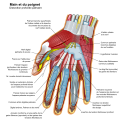Lêer:Wrist and hand deeper palmar dissection-numbers.svg

Size of this PNG preview of this SVG file: 474 × 600 piksels. Ander resolusies: 190 × 240 piksels | 379 × 480 piksels | 607 × 768 piksels | 809 × 1 024 piksels | 1 619 × 2 048 piksels | 555 × 702 piksels.
Oorspronklike lêer (SVG-lêer, normaalweg 555 × 702 piksels, lêergrootte: 207 KG)
Lêergeskiedenis
Klik op die datum/tyd om te sien hoe die lêer destyds gelyk het.
| Datum/Tyd | Duimnael | Dimensies | Gebruiker | Opmerking | |
|---|---|---|---|---|---|
| huidig | 17:15, 1 Junie 2015 |  | 555 × 702 (207 KG) | Perhelion | optimize image |
| 11:42, 8 Julie 2012 |  | 555 × 702 (399 KG) | Wilfredor | optimize image | |
| 21:11, 13 Januarie 2009 |  | 555 × 702 (817 KG) | Wilfredor | {{Information |Description= |Source= |Date= |Author= |Permission= |other_versions= }} | |
| 16:37, 16 Oktober 2008 |  | 555 × 702 (815 KG) | Wilfredor | {{Information |Description= |Source= |Date= |Author= |Permission= |other_versions= }} | |
| 19:33, 23 Julie 2008 |  | 770 × 767 (822 KG) | Bibi Saint-Pol | {{Created with Inkscape}} == {{int:filedesc}} == {{Information |Description= {{en|The hands (med./lat.: manus, pl. manūs) are the two intricate, prehensile, multi-fingered body parts normally located at the end of each arm of a human or other primate. Th |
Lêergebruik
Die volgende bladsy gebruik dié lêer:
Globale lêergebruik
Die volgende ander wiki's gebruik hierdie lêer:
- Gebruik in ar.wikipedia.org
- Gebruik in az.wikipedia.org
- Gebruik in bjn.wikipedia.org
- Gebruik in bn.wikipedia.org
- Gebruik in br.wikipedia.org
- Gebruik in ce.wikipedia.org
- Gebruik in crh.wikipedia.org
- Gebruik in cv.wikipedia.org
- Gebruik in da.wikipedia.org
- Gebruik in de.wikipedia.org
- Gebruik in en.wikipedia.org
- Wikipedia:Featured picture candidates/Wrist and hand deeper palmar dissection-en.svg
- Wikipedia:Featured picture candidates/April-2009
- User:Madhero88/Medicalg
- Wikipedia:WikiProject Anatomy/Resources
- Wikipedia talk:WikiProject Anatomy/Archive 9
- User talk:Rhododendrites/Reconsidering FPC on the English Wikipedia
- Gebruik in es.wikipedia.org
- Gebruik in fa.wikipedia.org
- Gebruik in fr.wikipedia.org
- Gebruik in hr.wikipedia.org
- Gebruik in hu.wikipedia.org
- Gebruik in id.wikipedia.org
- Gebruik in incubator.wikimedia.org
- Gebruik in iu.wikipedia.org
- Gebruik in ko.wikipedia.org
- Gebruik in lbe.wikipedia.org
- Gebruik in lb.wikipedia.org
- Gebruik in lt.wikipedia.org
- Gebruik in ms.wikipedia.org
- Gebruik in nia.wiktionary.org
- Gebruik in os.wikipedia.org
- Gebruik in pl.wikipedia.org
- Gebruik in pt.wikipedia.org
- Gebruik in ru.wikipedia.org
Wys meer globale gebruik van die lêer.







